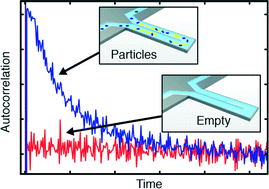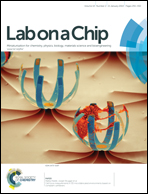Resolution enhancement of suspended microchannel resonators for weighing of biomolecular complexes in solution†
Abstract
We introduce the use of correlation analysis to extend the dynamic range of suspended micro- and nanochannel resonator (SMR/SNR) mass sensors by over five orders of magnitude. This method can analyze populations of particles flowing through an embedded channel micromechanical resonator, even when the individual particle masses are far below the noise floor. To characterize the method, we measured the mass of polystyrene nanoparticles with 300 zg resolution. As an application, we monitored the time course of insulin amyloid formation from pre-fibrillar aggregates to mature fibrils of 15 MDa average mass. Results were compared with thioflavin-T (ThT) assays and electron microscopy (EM). Mass measurements offer additional information over ThT during the fluorescent inaccessible lag period, and the average fibril dimensions calculated from the mass signal are in good accordance with EM. In the future, we envision that more detailed modeling will allow the computational deconvolution of multicomponent samples, enabling the mass spectrometric characterization of a variety of biomolecular complexes, small organelles, and nanoparticles in solution.


 Please wait while we load your content...
Please wait while we load your content...